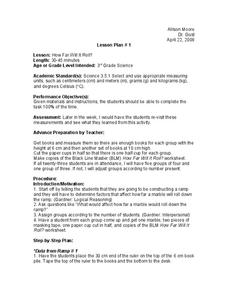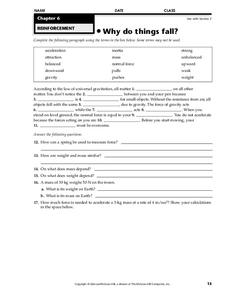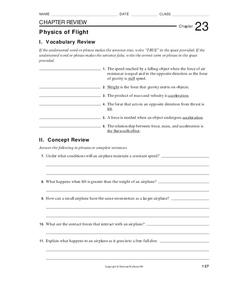Curated OER
Finding Balance
Learners explore how an artist uses the force of gravity to create balance in a sculpture. In this sculpting lesson, students create their own sculpture applying concepts from the lesson.
Curated OER
How Far Will It Roll?
Third graders investigate physics by conducting an experiment. In this gravity lesson, 3rd graders create a ramp using books and paper which they roll a marble down. Students utilize the scientific method to predict and...
Curated OER
Parachutes: What a Drag
Sixth graders make 2 different kinds of parachutes and record and graph the time for each one for the different drag forces. In this parachute lesson plan, 6th graders compare the results to the rest of the class of each parachute and...
Curated OER
Snapshot Day Definitions and Activities
Here is a document full of teaching notes on water quality and bodies of water that you can use in your ecology curriculum. It has information specific to the Hudson River area, but can easily be adapted to any local body of water....
Curated OER
What Makes a Kite Fly?
Ninth graders compare the nature of forces of gravity, lift, thrust, and drag. They select proper materials for making a kite and attach a proper tail. Students interpret and summarize the observations made during the flight of the kites.
Curated OER
What's it Like Inside the Sun?
Students perform experiment in which they model convection as it occurs in our Sun. They also explain that convection acts where the effect of gravity and heat are present (low density fluids can rise and cool, and high density fluids...
Curated OER
What Floats Your Boat?
Students discover the Archimedes principle through a buoyancy experiment. They measure the water displacement of a lump a clay which is denser than water then reshape the clay into a bowl which floats but displaces more water.
Curated OER
Weight, Friction, Equilibrium
For this weight worksheet, students review the equation for solving for the force of weight and review the kinds of friction. Students complete 10 matching, 7 fill in the blank, and 8 problems to solve.
Curated OER
Why Do Things Fall?
In this science worksheet, students complete a paragraph using 15 given terms. For example, "How can a spring be used to measure force?"
Curated OER
Student Exploration: Weight and Mass
In this student exploration-weight and mass worksheet, student use the Weight and Mass Gizmo to answer questions and fill in charts with estimating and measuring.
Curated OER
Torque Play
In this physics activity, students use torque to explain several very odd phenomena. They write the definition of torque and the relation between torque and change in angular momentum.
Curated OER
Newton: Force and Motion
In this forces instructional activity, students use the equations for acceleration and Newton's second law to learn about different motions and forces. This instructional activity has 7 problems to solve.
Curated OER
Do Some Research - Tides
In this science research worksheet, students use the library or Internet to determine what the regular changes in the level of water caused by the moon's gravity is called. They write the answer on the blue line, write a short essay...
Alabama Learning Exchange
Investigating Friction
Young learners explore friction. They view a video or DVD (bibliography provided) and define terms related to friction, and work in groups to experiment with the effects of friction on speed and motion using ramps and toy cars.
Curated OER
Magnets 2: How Strong is Your Magnet?
Learners work together to test the strengths of various types of magnets. After testing, they create a graph showing how the strength changes as the distance from the magnet increases. They discuss how forces can act from various...
It's About Time
Run and Jump
Has your class wondered how fast a human could run or how high they are capable of jumping? Help them understand these concepts as they explore acceleration and use an accelerometer to make semiquantitative measurements of acceleration...
Curated OER
Typical Numeric Questions for Physics I - Work and Energy
A total of 29 word problems furnish practice in solving for work, energy, and force. A few of the questions display diagrams to help learners visualize the systems, and all of them list five choices from which they select the correct...
Curated OER
Water and Ice
Students participate in various air experiments to understand that air is all around us. In this states of matter lesson, students focus on the role of air in the water cycle. Students understand that air is densest near the ground....
Curated OER
A Different Point of View
Fourth graders imagine what North Carolina looks like from the air. Looking at a map, they list the different kinds of views we might find, (i.e., beach, mountains, cities, farms, etc.) then attempt to draw their own version of a map.
Curated OER
Weather Lesson 1
Students describe and compare the layers of the atmosphere. They explain how to measure the temperature of the atmosphere. They also explain what causes the atmosphere to heat up in some places more than in others.
Foundation for Water & Energy Education
Perpetual Flow Activity
Set up a demonstration of how gravity can drive the perpetual flow of water during your hydro power unit. Science learners work in teams to make observations and formulate questions about how it works. They compare the model to what they...
Curated OER
Fall 2004 Midterm Exam #1, Parts A & B
First year physics learners show what they know about electric potential, circuits, power, current, and voltage on this midterm exam. It consists of a multiple choice section, some true or false questions, and two multi-step problems to...
Curated OER
Physics of Flight
In this flight worksheet, students will review the physics behind flight including lift, acceleration, and thrust. Students will also understand the Bernoulli effect. This worksheet has 6 true or false, 6 short answer, and 8 matching...
Curated OER
Space Weight, Gravity, and Distance
In this planets in space activity, students calculate their weight on the 9 planets plus calculate the distance of the planets from the sun in astronomical units. This activity has 6 fill in the blank and 3 short answer questions.























